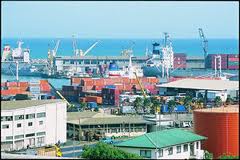The persistent issues of congestion and delays in the clearance processes at the country’s ports can be addressed through the effective implementation of post-clearing audits, says Mr. Derek Clay, Managing Director of Webb Fontaine, one of the five destinations inspection companies.
A post-clearance audit, he explained, is a system that allows for all goods -- except suspicious and contraband goods -- to pass through the ports, after which trade documents are be used to retrieve the charges.
“As trade increases, it is evident that Customs cannot always meet the demand for personnel. Therefore, to ensure speedy clearance of goods, authorities must identify and focus more on high-risk areas and allow goods to flow in low-risk areas. For instance, items like narcotics, pornography materials, and unwholesome goods should be restricted.
“This is because when it comes to money, you can collect the through post-clearance audit of trade documents to recoup the exact payable charges.
“Aside from such contraband goods, all other cargoes can be allowed to pass through the border or ports for post-clearance auditing to handle the monetary aspect,” he told B&FT in an interview on the sidelines of the opening ceremony of a three-week training course for officials from the Customs Division of the Ghana Revenue Authority, the Ministry of Trade and Industry (MOTI) and Webb Fontaine on the World Trade Organisation’s agreements on Customs valuations and post-clearance audits.
He however warned that the benefits of such a system can only be realised under a highly effective post-clearance audit regime.
About 70 participants will be trained on the core values of the post-clearance audit in the three-week course; and the exercise forms part of Webb Fontaine’s contractual obligations, like all other destination inspection companies, to periodically improve the knowledge-base of the various stakeholders involved in the country’s ports operations.
Destination inspection companies (DICs) have over the years introduced automated systems to boost trade facilitation at the country’s ports, among which is the Computerised Risk Management System (CRMS).
The CRMS ensures a more efficient allocation of Customs' limited resources by designating the appropriate level of intervention required for each import transaction. To achieve fast clearance of goods at the ports, there has been need to limit physical inspections of containers by focusing on “high-risk” imports.
Currently about 47% of imports coming through the ports are examined using x-ray scanners -- as against 100 percent physical examination that existed previously.
The scanners uses risk-profiling to determine risk levels of shipments-- that is, high-risk goods using the Red Channel (physical examination); medium-risk goods through the Yellow Channel (scanning or low-level physical examination); and low-risk goods through the Green channel (cursory or no examination).
There are currently five DICs contracted by the Ministry of Trade and Industry on behalf of the Government of Ghana to offer destination inspection services on imports into the country. Destination inspection has as its core objective trade facilitation and revenue enhancement without compromising security.
Over the years, interventions of DICs have assisted government to generate revenue that would otherwise have been lost because of lacking resources to do efficient price-verification and examination.
Business News of Tuesday, 20 August 2013
Source: B&FT
‘Use post-clearance audits to speed clearance at ports’













